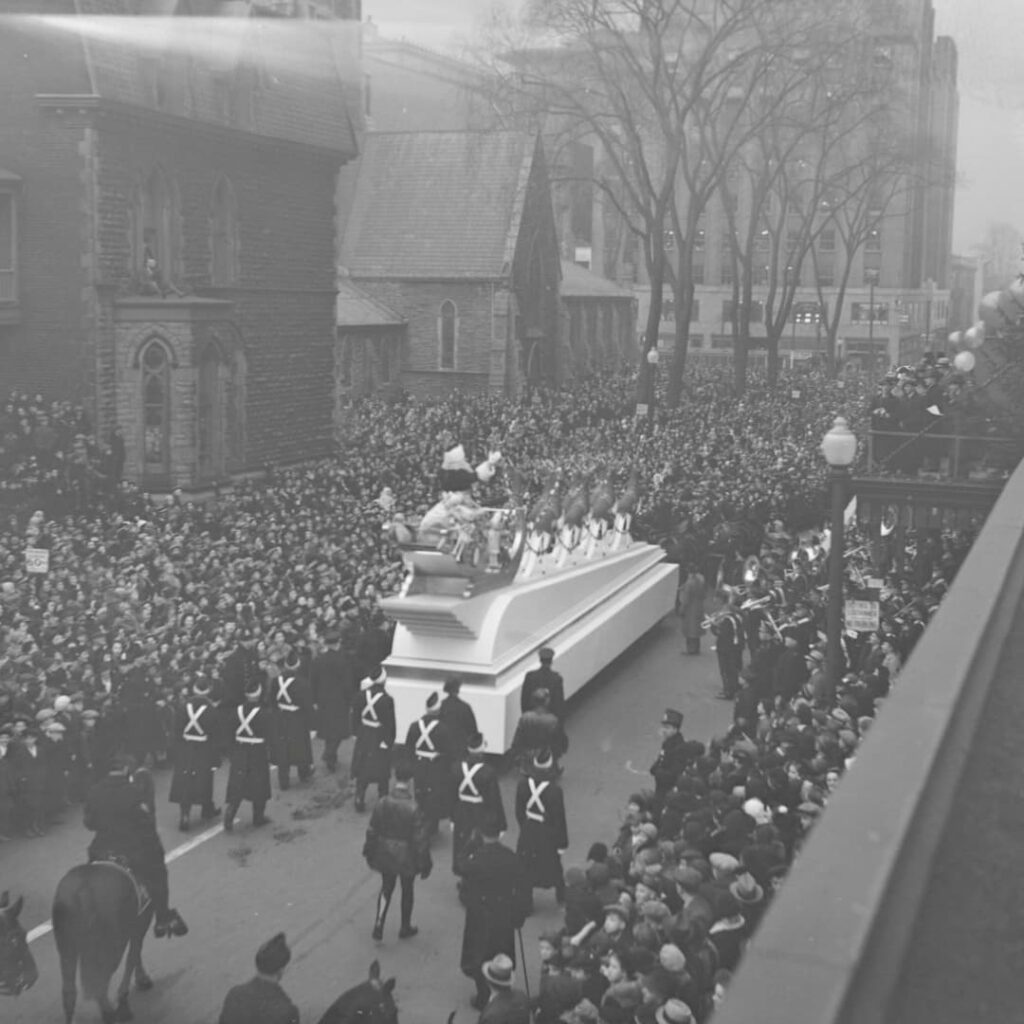Nov. 17, 2023
The history of Sainte-Catherine Street

Sainte-Catherine Street is opening up its archives and inviting you to embark on an open-air tour of its oases, spanning from McGill to Drummond streets, via Dorchester Square. This immersive and contemplative collection of photographs retraces the key moments in the history of Sainte-Catherine Street. It’s a slice of history waiting to be discovered!
Mythical and cosmopolitan, Sainte-Catherine—a place to call home, to visit, or to work—is a street like no other. Beyond the enigmatic origins of its name, its history is intricately woven with that of Montréal. A bustling, vibrant, and trendy thoroughfare, it’s a street of endless possibilities, where you can always find a restaurant to dine, an office to work in, or a show to escape the routine. Sainte-Catherine carries decades of history and stories and an identity shaped by students from the world over and entrepreneurs from diverse backgrounds. Today, Sainte-Catherine is reinventing itself to carry on its cultural, economic, and social role in our community.

From a modest path to a great destiny
It’s hard to imagine that before it became one of the city’s main streets, Sainte-Catherine Street was a narrow country lane crossing local farmers’ fields. Yet in the mid-18th century, what now links Westmount to Hochelaga-Maisonneuve was nothing more than a rural road meandering through Montréal from west to east. Its history began in 1758 in the Faubourg Saint-Laurent.
From Saint-Alexandre Street to Sanguinet Street in 1788, Sainte-Catherine gradually expanded from east to west, reaching Panet in 1820, De Lorimier in the 1850s, and du Havre in Hochelaga, finally crossing the entire Maisonneuve District between 1890 and 1910. The street extended west of Saint-Alexandre Street a little later. It reached McGill Avenue in the early 1840s, then Guy Street in the 1850s, before continuing on to Greene Avenue in Westmount (1872) and Victoria Street (1880).
Beyond its expansion, the street’s very vocation was evolving. In 1870, most commercial activity on the island was still concentrated in Old Montréal. But in the second half of the 19th century, the intensification of industrialization prompted the bourgeois elites of the old town to move towards Mount Royal, bringing in their wake numerous merchants who opened up stores on Sainte-Catherine Street.
Some prominent names include Dupuis Frères (1882), Morgan (1891, later becoming The Bay in 1960), Simpson (1905), and Canada’s most famous and important retailer, the Eaton company (1925). The arrival of the electric tramway (1890) made access to the growing number of shops along the street more convenient. Sainte-Catherine’s commercial importance was confirmed: a new town centre was born.

When growth beckons vitality
By the late 19th century, Sainte-Catherine Street had undergone a remarkable transformation. The 11.2-kilometer thoroughfare was now home to more than 800 stores, bustling year-round, day and night. Some called it home. Many enjoyed its attractions. And over 15,000 people worked there every day. With its multitude of restaurants, cinemas, cabarets, nightclubs, and sports and entertainment venues, Sainte-Catherine had become a prime destination for shopping, entertainment, and celebrations.
In the post-war period, the economy boomed and stores flourished. Sainte-Catherine was alive and buzzing. One of the highlights of the year was the holiday season with the Santa Claus Parade, initiated by Timothy Eaton, founder of the retail chain of the same name, in 1925. The parade initially featured Santa Claus parading through downtown. But over the years it grew with the addition of several floats and characters. As many as 10,000 children played extras, dressed in costumes custom-made by Eaton’s staff. This cherished tradition marked the start of the holiday season in downtown Montréal and the beginning of the gift-buying season.

Not to be outdone, the western end of Sainte-Catherine was home to the Forum, located at the corner of Atwater Street. A hockey temple and home to the Canadiens from 1926 to 1996, this national historic site, officially recognized as such in 1997, provided sports fans with seventy years of unforgettable moments.
To the west, Place des Arts was inaugurated in 1963. Over the decades, this massive cultural and artistic complex became one of Montréal’s key cultural hubs and was the future heart of the Quartier des spectacles.
In addition to shopping, Sainte-Catherine was also a hub of architectural excellence. Stunning buildings were designed to accommodate office space, including the Dominion Square Building, Phillips and Dorchester Squares, and Place Ville Marie, to name a few. Tens of thousands of employees flocked there daily to work and access nearby services.
In 1925, Eaton inaugurated a splendid Art Deco-style restaurant on the 9th floor, an exceptional venue to reopen in spring 2024.

Sainte-Catherine still has a long way to go
At the end of the 1960s—and for several decades to follow—the Montréal economy faced headwinds. Some established names disappeared (Dupuis, Eaton, Simpson), while newcomers emerged, such as Complexe Desjardins (1976), Promenades de la Cathédrale (1988), and Place Montréal Trust (1988). During this period, academic and research institutions like UQAM (to the east) and Concordia University (to the west) were established, attracting thousands of students to their campuses.
Starting in 1994, Sainte-Catherine Street experienced a revival, thanks to the growth in tourism and the development of Montréal’s cultural life. Museums, theatres, conventions, and international events: Sainte-Catherine attracted thousands of visitors for business and pleasure. Several major hotels were built in the downtown area, and in 2000, the Quartier des spectacles project marked a turning point in making Montréal a world-class cultural destination.
Today, the street continues its transformation, tapping into its history to enrich its future: modernization of Sainte-Catherine Street West, revitalization of the iconic Phillips and Dorchester squares, creation of Oscar-Peterson Square and McGill Avenue, renovation of Place Ville Marie, development of the The Bay store. All these projects strengthen the identity of Sainte-Catherine, a street with a name of mysterious origins, but with a uniqueness all its own.

This project is made possible with the support of the City of Montréal and in collaboration with the Partenariat du Quartier des spectacles.
Photographs: Bibliothèque et Archives nationales du Québec


